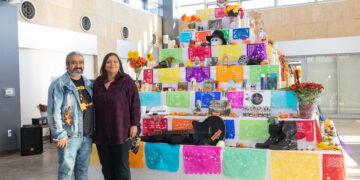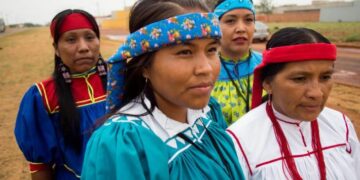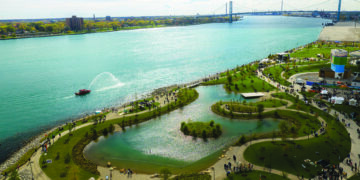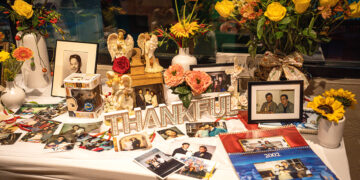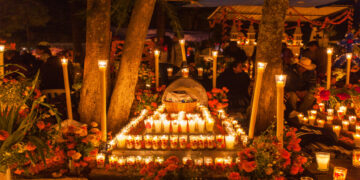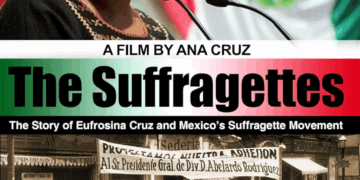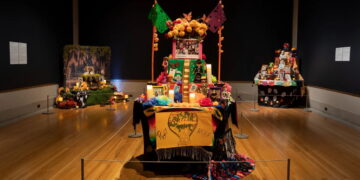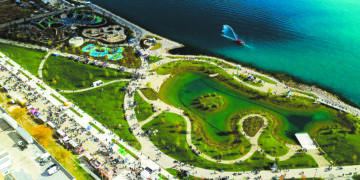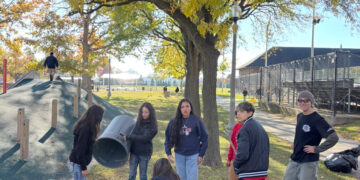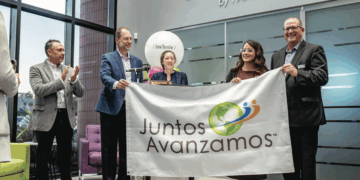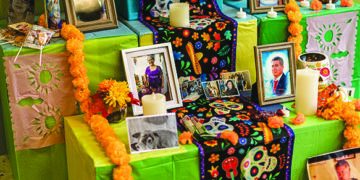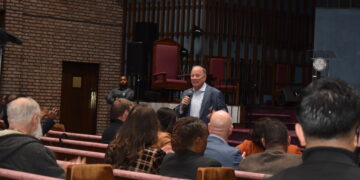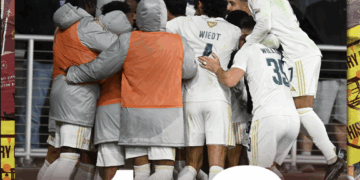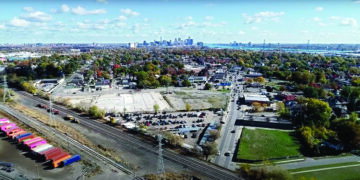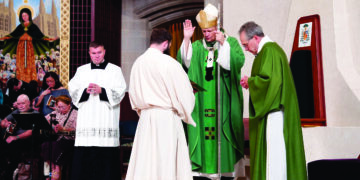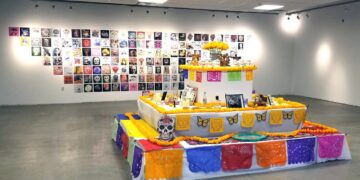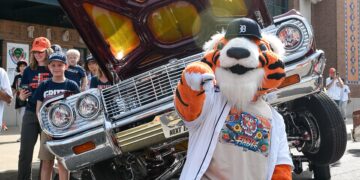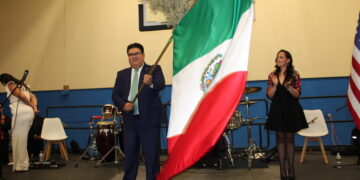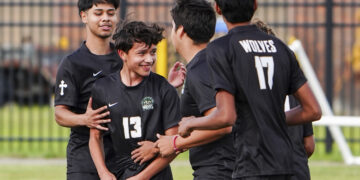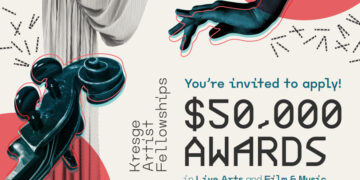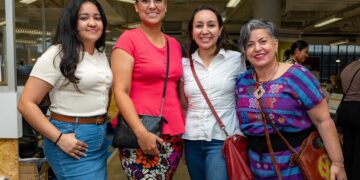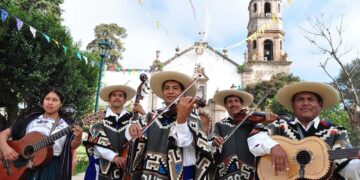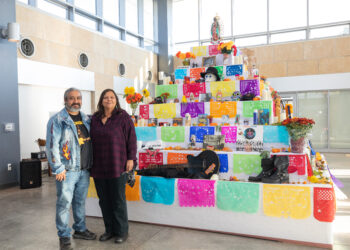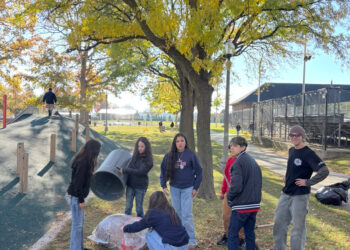On Saturday, June 28, Southwest Detroit will unveil the Bagley Arts Alley, a transformed space that tells the story of Mexicantown’s multicultural heritage as depicted by five diverse artists through the medium of murals and mosaics. The celebration at 2631 Bagley, next to the Roberto Clemente Recreation Center, begins at 12pm with programming at 12:15pm as part of Detroit’s citywide initiative to convert nine neglected alleys into vibrant community gathering spaces.
Along with a mosaic installation, the three murals on the recreation center walls thematically intertwine to tell a Detroit-centric story about the city’s multicultural roots. The first to be painted, Trae Isaac’s vibrant spray-painted “Women of the Ojibwe” anchors one end, closest to Bagley. On the other end, Chicago-based Waleed Johnson’s mural depicts an intergenerational scene of an older woman helping a young girl tend to flowers. Centered is Ani Garabedian’s mural entitled “Symbiosis,” which portrays a man tenderly holding a chicken, set against an explosive array of dahlia flowers, the official flower of Mexico. A 135-foot wall adorned with mosaic on cinder block by project partners Vito Valdez and Christine Bossler spans the entirety of the alley opposite the murals.
“I did extensive research on the area, and I was able to find something that was not only representative of the area but aesthetically gave a similar identity to how Southwest Detroit identifies today,” Isaac explained.
Isaac and the other artists were selected from over 130 applicants through their submitted proposals, with creative direction coming directly from neighborhood residents. Community suggestions influenced everything from color choices to incorporating floral elements that complement a planned garden installation.

Isaac worked for three days straight to finish his piece, using spray paint techniques he’s been perfecting for years. His path to art wasn’t typical, moving from amateur boxing to finding his voice through “pop realism.” “I create for the community, and I create about the community,” he said.
After finishing his first mural in Detroit’s District 6, Waleed Johnson posted on his Instagram account about the experience: “I’ve long felt Southwest Detroit is one of the most vibrant areas in the city and I’m glad to have a piece there among so many other great pieces of street art.” But maybe the best part of his reflection was this detail: “I will definitely miss the daily smell of fresh tamales being cooked wafting over to the mural site.”
Working alongside other artists created a different experience than Ani Garabedian’s usual solo projects. “I’ve done a lot of murals up to this point and it can be a very solo endeavor,” Garabedian noted. “But in this, I have murals going on on either side of me as well as this gorgeous mosaic project that two other artists are working on behind me and it was really cool.”
Garabedian’s community engagement process worked through local representative Cinthya Casillas, who gathered feedback from neighborhood residents and relayed suggestions back to her.
Garabedian’s painting perfectly captures a moment in Detroit’s evolution: a man tenderly holding a chicken. Garabedian, who manages community programs at the Detroit Institute of Arts and teaches at Wayne State, noticed something during her visits to the area. “I was hearing a lot of chickens,” she said, which made perfect sense given Detroit’s new Urban Animal Ordinance that lets residents keep up to eight chickens and ducks with proper licensing.
But Garabedian sees something deeper than just farming. “The idea was holding [the bird] with care and love,” she explained. “More so than something that’s of use or utilitarian, there’s an emotional connection.” Her mural addresses how “these relationships have evolved over time as modern farming practices have changed, and animal welfare has become compromised. Animals are not just property or a commodity.” That focus on caring for animals comes from her own volunteer work with dog rescue around Detroit. She surrounded the figures with dahlia flowers both to honor the neighborhood and help all three murals work together visually.
Isaac gets why this location matters. Having a piece in Southwest Detroit feels like “a badge of honor” to him because the area has such a strong artistic reputation. “I view Southwest as having its own aesthetic and identity in the art scene and art culture,” he said, pointing to the neighborhood’s graffiti scene and the serious skill it takes to master spray paint.
Then there’s the mosaic work that anchors the whole project. Vito Valdez and Christine Bossler spent months developing intricate Quetzalcoatl designs – the Feathered Serpent from Aztec culture – along the cinder block wall that separates the space from Mexican Village restaurant’s parking lot. Their partnership goes back 20 years, starting when Bossler assisted Valdez’s late partner, Mary Laredo Herbeck, on Southwest Detroit public art projects.
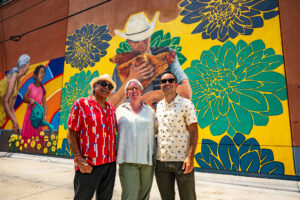
“We’ve been working together on and off for the last 20 years,” Bossler explained, describing how their partnership deepened after Laredo Herbeck’s passing when they began restoring existing public art benches in the neighborhood. Valdez described their collaboration as splitting the work “50/50 right down the line,” with Bossler and her husband joining the team to bring the vision to life.
Valdez didn’t pick Quetzalcoatl casually. The deity was connected to “wind, Venus, sun, merchants, arts, crafts, knowledge and learning” and “considered patron god of the Aztec priesthood.” Bossler brought her metalsmithing and ceramics background to complement Valdez’s color sense and design vision. They transformed recycled roof copper from the Detroit Institute of Arts into detailed edging, cutting the copper into “spiculum” forms, or geometric tubes that taper at both ends. All the stars, moon, and copper accent scales came from a hydraulic die she designed just for this work. Bossler studied Mesoamerican and Native American art history, so working on indigenous themes with Valdez felt like everything coming together.
Valdez has Southwest Detroit in his bones. Born in Wyandotte but raised in the neighborhood, he’s part of that classic Detroit story—family migrating from El Paso, Texas, for auto plant jobs. He lived abroad for years as an artist, working in Montreal and Europe, but family brought him home, especially his daughter.
“I’m a community activist,” Valdez explained in a 2019 interview with the Detroit Historical Society’s “Neighborhoods: Where Detroit Lives” Oral History Project. “In doing public art, it’s a voice for people. Community is communication.”
Three groups made the Bagley Arts Alley possible: the City of Detroit’s Office of Arts, Culture and Entrepreneurship (ACE), SpaceLab Detroit, and City Walls. The initiative commissioned 47 artists across all nine alleys, bringing together muralists alongside artists creating mosaics, portraits, and sculptures.
SpaceLab Detroit, which issued the open call on behalf of the city, operates as what they describe as “a vibrant hub where smart, innovative solutions thrive,” connecting artists, designers, and creators while partnering with city leaders on public art projects. City Walls brings experience in blight remediation and public art through their artist residency programs.
The project shows how Detroit works: different backgrounds, same values. Isaac went from boxing to art after personal tragedy struck his family, while Garabedian came through art school and institutions, but the community selection process treated both paths equally. “There’s no right way and there’s no wrong way,” Garabedian said. “We all find our own path. There’s lots of right ways to do one thing.”
As residents and visitors gather for the opening celebration on Saturday, June 28th, they’ll see artwork designed to reflect their community back to them. Isaac put it simply: this looks like work that “belongs there.”
Bagley is one of nine alleys getting the art treatment this month. There’s the North End’s Agri-Arts Alley next to Oakland Avenue Urban Farm, and the Passage to Wellbeing Alley with its Manistique Community Treehouse. Each one fits its neighborhood, but they all share the same idea: public art brings people together. Whether people gather here regularly or just appreciate the art while passing by is beside the point. The real value is that Detroit’s creative community grew through genuine collaboration between artists, residents, and city institutions.
Everyone had a voice that counted.
Michael D. Gutierrez is the Digital Content Manager for EL CENTRAL Hispanic News. He is a screenwriter and filmmaker with a decade of experience in the television and film industry, contributing to projects including THE HOLDOVERS and LETHAL WEAPON on Fox. He is an active member of the Writers Guild of America-West and its Latino Writers Committee.
This article was made possible thanks to a generous grant to EL CENTRAL Hispanic News by Press Forward, the national movement to strengthen communities by reinvigorating local news. Learn more at www.pressforward.news.

